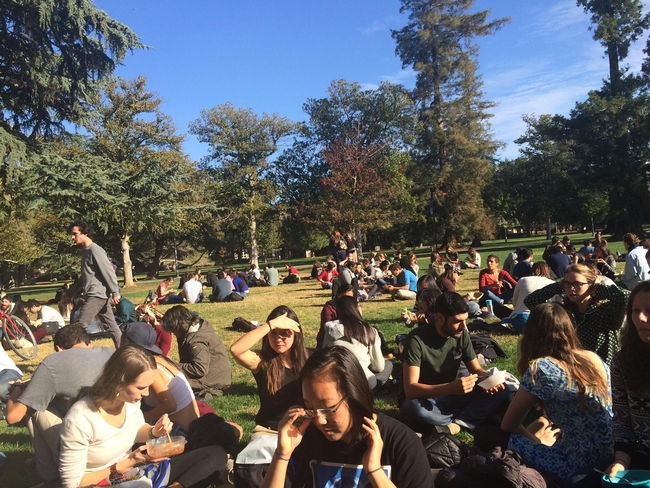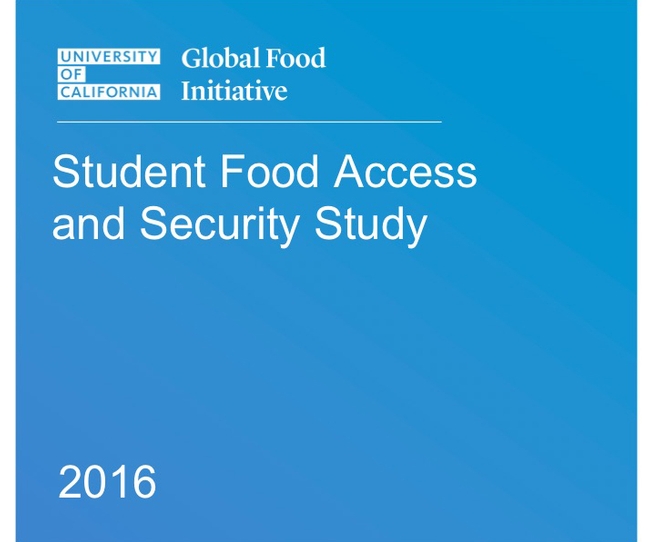Posts Tagged: Nutrition
Study finds schools across the nation have too much lead in drinking water
Despite increasing awareness of the issue of lead in drinking water, UC Nutrition Policy Institute and Harvard School of Public Health researchers found that many students in the U.S. attend public schools in states where not all taps are tested for lead, according to reports in various media outlets including The Guardian, NBC News and The Nation.
“All kids, no matter where they live, should have access to safe drinking water in school,” said Angie Cradock of Harvard's Prevention Research Center on Nutrition and Physical Activity, who led the study team. “Drinking water is important for helping kids grow up healthy, and water should be safe to drink.”
The researchers found that there is no uniformity in states' approaches to create and oversee programs to test for elevated lead in school drinking water. When collected, data are not regularly made available to guide action to reduce potential exposure to lead. About half of the country's students are at public schools in states that don't have programs or requirements to test drinking water in those schools.
Of the 24 states (plus Washington, D.C.) with a statewide program to test school drinking water for lead, only 12 states had data that could be analyzed by the research team. In these 12 states, 44 percent of all schools had at least one tap that tested higher than their state's threshold for action, and 12 percent of all samples had a lead concentration higher than the state's action level. The report also describes the features of statewide initiatives in operation between Jan. 1, 2016, and Feb. 28, 2018, in 24 states and the District of Columbia to conduct testing for lead in school drinking water.
The report was funded by Healthy Eating Research, a national program of the Robert Wood Johnson Foundation.
For more information, see the Harvard T. H. Chan School of Public Health website.
Popular Japanese tea matcha has health benefits
Matcha, finely ground powder made from baby green-tea leaves, is growing in popularity due to health benefits and the natural woodsy flavor it imparts to drinks, pastries and savory dishes, reported Jenice Tupolo and Carla Meyer in the Sacramento Bee.
To find out if the most-prized tea in Japan lives up to its purported health benefits when scrutinized scientifically, the reporters contacted UC Cooperative Extension specialist Sheri Zidenberg-Cherr.
“The health benefits are similar to that of green tea in general,” Zidenberg-Cherr said. Possible benefits of green tea include lower risk of cardiovascular disease and some types of cancers, and bone-density improvement. Though "the studies are pretty inconclusive," she said, some have been promising.
"Some have shown a benefit of maybe three cups a day in terms of reduced risk of cardiovascular disease especially," she said.
Zidenberg-Cherr cautioned against taking matcha or green tea with dairy milk.
UC students in 'protected environment' are vulnerable to food insecurity
Many people are surprised to learn that students enrolled in the state's premiere higher-education system are vulnerable to food insecurity, said Suzanna Martinez, a researcher with UC ANR's Nutrition Policy Institute, on the KPFA radio program Up Front. (Martinez's segment begins at the 20:23 mark.)
Martinez was interviewed for the program by host Pat Brooks, who was sitting in for Dennis Bernstein. Martinez said that anecdotal evidence of food insecurity on UC campuses was already popping up when UC President Janet Napolitano provided funding to each of the campuses to address the issue. The UC president also provided funding to the UC Nutrition Policy Institute to survey students across the system to document and understand food insecurity on UC campuses.
The report, issued last week, was based on the responses to a survey by about 9,000 students. Nineteen percent indicated they had “very low” food security and an additional 23 percent were characterized as having “low” food security. The greatest impact, Martinez said, was on the Latino and black student populations. Most of the students struggling with food insecurity had never experienced such circumstances before going away to college.
In response to the survey, Napolitano approved $3.3 million in new funding over the next two years to help students regularly access nutritious food on campus and off.
Brooks asked Martinez what is the new report's 'call to action.'
"Our hope is to eliminate food insecurity, and with this report we are hoping that others will be dedicated to this and committed to the work as well,” Martinez said.
UC commits $3.3 million to improve student access to nutritious food
Guided by the findings of a survey conducted by UC ANR's Nutrition Policy Institute, UC President Janet Napolitano announced July 11 she would commit $3.3 million in new funding over the next two years to help UC students regularly access nutritious food. UC's survey findings and response were reported by the San Francisco Chronicle, East Bay Times, Los Angeles Times, KCBS and KPCC.
The online survey was administered to a randomly selected sample of students from all 10 UC campuses in spring 2015. It is part of the UC Global Food Initiative, which promotes a nutritious, sustainable food supply.
According to the NPI survey, 19 percent of the nearly 9,000 participating UC students indicated they had “very low” food security, which the USDA defines as experiencing reduced food intake at times due to limited resources. An additional 23 percent were characterized as having “low” food security, defined by the USDA as reduced quality, variety or desirability of diet, with little or no indication of reduced food intake.
“I wasn't expecting that level of food insecurity in students,” said NPI director Lorrene Ritchie, who led the study, to Jessie Qian of the Daily Californian. “Adults who aren't informed would think students are just passive, spending their money on other things or just complaining … but it's really that big of a problem.”
According to the UC news release, UC has developed an action plan tailored to the needs of individual campuses while maximizing coordination among them. The plan includes:
- Expanding food pantry storage and access
- Increasing collaboration with state and county offices to register students for CalFresh, California's nutrition assistance program
- Establishing and expanding awareness campaigns on student support services and food access
- Expanding the existing Swipe Out Hunger programs, which allow university students to donate excess dollars on their meal plan to reduce hunger on campuses
- Integrating food preparation and secure storage space into new student housing design and construction
- Enhancing financial aid communications about housing and food costs
“Among students who reported food insecurity in the past year, we found that for 57 percent this was a new experience – not one they had faced as children,” says Ritchie. “This suggests that students who are on their own for the first time would benefit from financial literacy training and additional information about financial aid, nutrition assistance, and making healthy choices on a limited budget.”
The report Student Food Access and Security Study, authored by NPI research analyst Suzanna Martinez, UC Santa Barbara sustainability coordinator Katie Maynard and Ritchie, can be downloaded at http://npi.ucanr.edu.
UC ANR's Lauren Au is a nutrition hero
She doesn't wear a cape and mask, but childhood nutrition researcher Lauren Au was proclaimed a nutrition hero in Food & Nutrition Magazine. Au is a researcher with the UC Agriculture and Natural Resources (UC ANR) Nutrition Policy Institute
Food & Nutrition Magazine is published by the Academy of Nutrition and Dietetics, the world's largest organization of food and nutrition professionals. Au told the editors that she was drawn to nutrition and dietetics from a prevention perspective. Both her parents passed away from chronic disease at a young age.
"I wanted so desperately to prevent this hardship from happening to my close family and friends," Au said.
In her role with the Nutrition Policy Institute, she strives to fight and prevent childhood obesity by improving federal nutrition initiatives, such as the school lunch program and the national women, infants and children supplemental nutrition program (WIC).
"For example, our WIC research has shown that both online and in-person nutrition education can increase healthier breakfast behaviors, which has the potential to reach close to 8 million low-income mothers and children," Au said. Read more about the WIC research here.
Au told Food & Nutrition Magazine that she finds it personally rewarding to share compelling research with legislators and policy makers.
"It can be extremely powerful," she said. "I just received two large grants to examine the school nutrition environment and the relationship with childhood obesity over the past decade. I am excited to be able to help shape child nutrition legislation in years to come."






